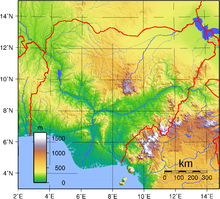Geography of Nigeria



Nigeria is a western African country, bordering the Gulf of Guinea, between Benin and Cameroon.
Geographic coordinates: 10°00′N 8°00′E / 10.000°N 8.000°E
Map references: Africa
Area:
total:
923 768 km²
land:
910 768 km²
water:
13 000 km²
Area - comparative:
- slightly more than twice the size of California
- slightly more than 3¾ times the United Kingdom's area
- about 0.12 times Australia's area
Land boundaries:
total:
4 047 km
border countries:
Benin 773 km, Cameroon 1 690 km, Chad 87 km, Niger 1 497 km
Coastline: 853 km
Maritime claims:
continental shelf:
200-m depth or to the depth of exploitation
exclusive economic zone:
200 M
territorial sea:
12 M
Climate: varies; equatorial in south, tropical in center, arid in north
Terrain: southern lowlands merge into central hills and plateaus; mountains in southeast, plains in north
Elevation extremes:
lowest point:
Atlantic Ocean 0 m
highest point:
Chappal Waddi 2 419 m
Natural resources: petroleum, tin, columbite, iron ore, coal, limestone, lead, zinc, natural gas, hydropower, arable land
Land use:
arable land:
33%
permanent crops:
3%
permanent pastures:
44%
forests and woodland:
12%
other:
8% (1993 est.)
Irrigated land: 9,570 km² (1993 est.)
Natural hazards: periodic droughts
Environment - current issues: soil degradation; rapid deforestation; desertification; recent droughts in north severely affecting marginal agricultural activities
Environment - international agreements:
party to:
Biodiversity, Climate Change, Desertification, Endangered Species, Hazardous Wastes, Law of the Sea, Marine Dumping, Marine Life Conservation, Nuclear Test Ban, Ozone Layer Protection
signed, but not ratified:
none of the selected agreements
